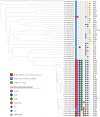Emergence and spread of a mupirocin-resistant variant of the European epidemic fusidic acid-resistant impetigo clone of Staphylococcus aureus, Belgium, 2013 to 2023
- PMID: 38726693
- PMCID: PMC11083972
- DOI: 10.2807/1560-7917.ES.2024.29.19.2300668
Emergence and spread of a mupirocin-resistant variant of the European epidemic fusidic acid-resistant impetigo clone of Staphylococcus aureus, Belgium, 2013 to 2023
Abstract
BackgroundAntimicrobial resistance to mupirocin and fusidic acid, which are used for treatment of skin infections caused by Staphylococcus aureus, is of concern.AimTo investigate resistance to fusidic acid and mupirocin in meticillin-susceptible S. aureus (MSSA) from community-acquired skin and soft tissue infections (SSTIs) in Belgium.MethodsWe collected 2013-2023 data on fusidic acid and mupirocin resistance in SSTI-associated MSSA from two large Belgian laboratories. Resistant MSSA isolates sent to the Belgian Staphylococci Reference Centre were spa-typed and analysed for the presence of the eta and etb virulence genes and the mupA resistance gene. In addition, we whole genome sequenced MSSA isolates collected between October 2021 and September 2023.ResultsMupirocin resistance increased between 2013 and 2023 from 0.5-1.5% to 1.7-5.6%. Between 2018 and 2023, 91.4% (64/70) of mupirocin-resistant isolates were co-resistant to fusidic acid. By September 2023, between 8.9% (15/168) and 10.1% (11/109) of children isolates from the two laboratories were co-resistant. Of the 33 sequenced isolates, 29 were sequence type 121, clonal and more distantly related to the European epidemic fusidic acid-resistant impetigo clone (EEFIC) observed in Belgium in 2020. These isolates carried the mupA and fusB genes conferring resistance to mupirocin and fusidic acid, respectively, and the eta and etb virulence genes.ConclusionWe highlight the spread of a mupirocin-resistant EEFIC in children, with a seasonal trend for the third quarter of the year. This is of concern because this variant is resistant to the two main topical antibiotics used to treat impetigo in Belgium.
Keywords: Belgium; Child; Exfoliatins; Fusidic Acid; Impetigo; Mupirocin; Staphylococcus aureus; Virulence; Whole Genome Sequencing.
Conflict of interest statement
Figures



References
-
- Rørtveit S, Skutlaberg DH, Langeland N, Rortveit G. The decline of the impetigo epidemic caused by the epidemic European fusidic acid-resistant impetigo clone: an 11.5-year population-based incidence study from a community in Western Norway. Scand J Infect Dis. 2014;46(12):832-7. 10.3109/00365548.2014.947317 - DOI - PMC - PubMed
-
- Belgian Antibiotic Policy Coordination Commission (BAPCOC). Guide belge de traitement anti-infectieux en pratique ambulatoire/Belgische gids voor anti-infectieuze behandeling in de ambulante praktijk. [Belgian guide for treatment of infections in outpatient practice]. Brussels: BAPCOC; Nov 2022. French/Dutch. Available from: https://organesdeconcertation.sante.belgique.be/fr/documents/guide-belge...
MeSH terms
LinkOut - more resources
Full Text Sources
Medical
Molecular Biology Databases
